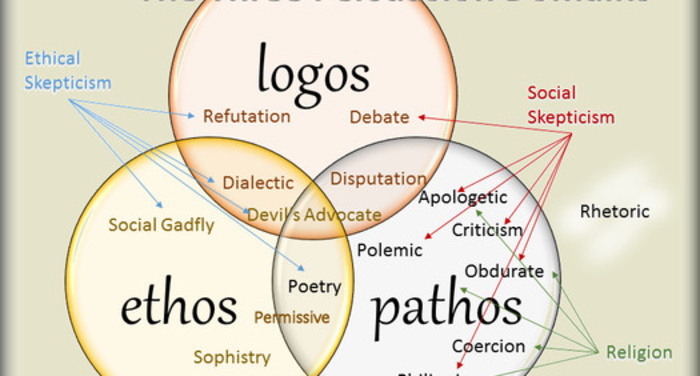
Where Do We Use Logos, Ethos, Pathos?
The ancient Greek philosopher Aristotle was the first one who started talking about the mechanics of persuasion. He provided three fundamental rhetorical strategies (logos, ethos, pathos rhetoric) that can help a speaker make any message more powerful and increase the likelihood of achieving the desired result. These concepts are deeply intertwined and work better when combined since you approach the task from different perspectives. When it comes to ethos pathos logos definition, one can say they represent three pillars you should lean on when persuading your target audience. So, let's go deep down the question, "What is ethos, pathos, and logos?"
Ethos
It is not a secret that many people prefer to interact with specialists who have enough experience under the belt and can prove their qualifications. So, if you want to convince your readers, you should demonstrate your credibility. It is when ethos rhetoric comes to the rescue since it aims at building trust and showing that you have a valid ground for discussing the subject. Thus, it suggests utilizing credentials that prove your expertise level. People tend to subconsciously evaluate someone's trustworthiness based on their qualifications and achievements. Let's consider a few examples:
- After graduation from Harvard University, I have been working for 15 years on mental issues in teenagers who have got an emotional trauma in childhood.
- I have participated in about ten World Health Organization forums for the last five years, including various lectures and conferences within my specialty.
- All our specialists have graduated from top-rated universities throughout the country and can boast of impressive research activities. Therefore, their high level of expertise in the field, combined with high technologies, allows them to meet any challenges.
Logos
A well-crafted paper seems logical and doesn't raise suspicions. Logos rhetoric is responsible for this aspect. In other words, if you bring arguments, you should make sure they seem obvious and rational, so your readers cannot come up with a more suitable alternative. Ideally, you should gradually provide all your arguments to push your readers to a logical conclusion before saying everything straightforward. Thus, they should have a feeling that they have formed this opinion themselves. Hence, logos in writing involves facts, statistics, research results, life experiences, or historical events that can convince your target audience. You may want to see an example of logos:
- Nowadays, more than 781 million people live below the poverty line. More than 11 percent of the world's population tries to access health, education, and sanitation services.
- While some are looking for ways to spice up their relationships, most couples prefer to solve the issue radically: over the past 40 years, people have started breaking up twice as often.
- The pandemic continues to spread around the world. According to Johns Hopkins University, the number of cases globally has exceeded 209 million, while deaths are 4,4 million worldwide.
Pathos
The last pillar you should remember is pathos rhetoric. This concept spins around sympathy, empathy, experiences, and emotions in general. Thus, it means that the persuasion process goes hand in hand with your reader's emotions, so you should trigger specific reactions with the help of the right words. Usually, advanced storytellers are good at such things since they can use meaningful language to appeal to readers' imaginations. People will treat your words seriously if you show that you care about what you are talking about. So, what is pathos in writing? It is about making your text elicit an emotional response in your target audience. The main thing here is to do it wisely. Otherwise, you may face an opposite reaction.
- A woman should not tell a man that she loves him since her shining, happy eyes are more eloquent than any words.
- Great things happen only when each team member does their part of the work perfectly. Just look at The Beatles. These guys kept under control their downsides and balanced each other. Their tremendous success was a team effort.
- While good people can make you happy, bad ones will provide you with priceless experiences, so you should appreciate all of them.
Tips for Incorporating Rhetorical Appeals in Your Writing
As you might have understood, utilizing ethos pathos logos together is a win-win option. So, if you want to make your text powerful, you should resort to these rhetorical appeals. They can be used in any form of communication, so whether you write a college paper, a blog post, or make a presentation, don't forget to utilize these techniques to persuade your audience.
- Choose your words and tone of voice correctly. It is better to talk about things you are good at since ethos begins before sharing your opinion. You should reach out to your audience and show your trustworthiness. That's why it is crucial to choose the correct tone of voice that will fit into your image.
- Decide on the emotions you want to evoke. You should take your time to decide what outcome you want to achieve with your speech. It will affect the range of emotions you need to trigger in your readers. Moreover, remember that you should not arrange an emotional roller coaster but adhere to the chosen emotions in the selected part of your message.
- Know your target audience. Your text will sound powerful if you get to know your readers closer and understand what phrases, data, and emotions will help you reach them out. Otherwise, your speech will hardly become successful.
Summing Up
Whether writing or talking to someone, you do your best to convey the key thought and perhaps make your interlocutor share your point of view. It can be a challenge if your text lacks some fundamental aspects. While ethos highlights your strong sides, logos focuses on the message itself, and pathos reaches out to your audience. It is a perfect combo you should consider when writing your text.
References
https://www.uis.edu/cas/thelearninghub/writing/handouts/rhetorical-concepts/ethos-logos-and-pathos/

Leave your comment here